Occurrence and Abundance of Corals and Coral Reefs in Oman
The corals of Oman are part of a great group of marine animals called the Indo-Pacific fauna that extends across the Pacific and Indian Oceans from the east coast of Africa to the west coast of the Americas. Many of the same types of corals that occur in Oman also live as far away as Hawaii, Tahiti, and the west coast of Panama. This region, therefore, represents the greatest continuous biological community on earth. However, the species composition of a coral reef will not be exactly the same from one area of the Indo-Pacific region to another. Rather, the most common types to be found in one area may be rare or even absent in another, depending on the environmental conditions that prevail and how far an area is from the zone of maximum abundance of that species. Interestingly, some of the coral species that are found in the Arabian Gulf and the Gulf of Oman are also among the most common in Hawaii, a half a world away, and are relatively uncommon at points in between.
The
maximum numbers of species of this great Indo-Pacific distribution of animals
occur in the warm tropical seas surrounding Indonesia and the
Philippines, and decrease in all directions from this central point.
Oman is relatively distant from this center of maximum diversity, and fewer
types of corals exist along Oman's coast than in most areas of the tropical
Indian and Pacific Oceans. Although high coverages of reef corals are found
in Oman, reef development is generally limited, and the number of coral
types present is low. Of over 700 coral species
identified for the Indo-Pacific region and over 200 for the Red Sea, only
about 75 reef forming species inhabit in Oman waters.
There are only four principal areas of coral growth along the entire 1,700 km Oman coast: 1) the khawrs and fjords of the Musandam Peninsula near the Strait of Hormuz, 2) the Muscat-Capital Area coast and islands from the Daymaniyat Islands to Ras al Hadd, 3) the south and west coast of Masirah Island and 4) the Dhofar area from the Al Halaaniyaat (Kuria Muria) Islands to Salalah. In none of these areas are coral reefs highly developed. Coral growth is generally restricted to those areas where they can grow directly on a rock substratum. Where reefs do occur, they are usually small and restricted to embayments or lee areas which are protected from wave disturbance. The exceptions to this are well developed reefs with a variety of coral species in the Damaniyat Islands and reefs made by the growth of a single species in the Gulf of Masirah southwest of Masirah Island and south of Barr al Hikman.
There are a number of reasons for Oman's limited species diversity, coverage and reef development, which are related to the biological requirements for reef coral survival and growth. First, there is the lack of a suitable substratum along most of Oman's coast. Most corals require a hard bottom for the settlement of their larval stage, called planula, to begin the first stages of calcification and development of the adult coral. The nearshore bottom, from the Al Halaaniyaat (Kuria Muria) Islands to Masirah Island, from Masirah to Ras al Hadd, and along the Batinah coast, is mostly loose sand and, therefore, unsuitable for coral settlement and growth. Second, the coastline of Oman is geologically young, having resulted from rising sea levels in the last 8;000 years, which have flooded former coastal plains and moved the shoreline landward by up to 10 kilometers. Therefore, there has been only a limited time for coral migration, colonization, growth and reef development on the limited amount of suitable bottom. Third, the physical environment of the Arabian Sea, and to a less extent, the Gulf of Oman, is highly variable and unstable, especially with respect to temperature. Because of the annual summer southeast monsoon and, the resulting upwelling of cold, deep water, the temperatures of the coral habitat fall to stressful levels, which may act to restrict the survival of many species and inhibit the growth rates of those species which do survive (Chapter 4).
Descriptions of Principal Coral Growing Areas in Oman
This region of Oman, which is separated from the main portion of the country by the U. A. E., has a coastline on either side of the Strait of Hormuz, along both the Gulf of Oman and the Gulf of Arabia. Both areas are typified by sheer walls which extend steeply to depths of 40 m close to the shoreline and by fjord like inlets (khawrs) which follow the wadi courses. Since the Musandam shoreline is rapidly subsiding into the ocean and is exposed to waves and rock boring animals, the sheer rock surfaces are continually eroding off and tumbling into the depths. The substratum for coral settlement is therefore unstable and there has been limited chance for development of coral reefs except at the heads of khawrs which are not subject to sedimentation. Air temperatures within the khawrs soar during summer months, exposing corals to temperatures that are probably the highest in Oman waters, and cause stress to corals that may approach or exceed their tolerance limits (Chapter 4).
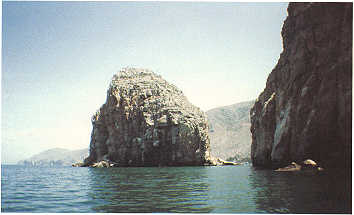
Coral coverage is generally limited and highly variable, depending on the local environmental conditions and the availability of a stable bottom at depths and temperatures suitable for coral growth. The greatest coral abundances occur in shallow bays. in areas sheltered from wind and wave action, and where the bottom is relatively flat and turbidity is relatively low. Coral growth consists primarily of a thin veneer of corals growing directly on bedrock, with infrequent patch reefs, usually composed of growth by a single species. Also. fewer coral species occur overall than further south and east along Oman's coast. Surveys have found only 51 reef forming corals to be present along the Musandam coast, compared to 61 in the Capital Area; while 10 non-reef forming corals can be found compared to 7 in the Capital Area.
This area extends from the As Sawadi and the Daymaniyat
Islands on the west to Ras Abu Daud on the east and includes some of the
best growth of hard corals and development of coral reefs that occur in
Oman. Being located in the population center of the country, the Capital
Area affords the greatest opportunity for both visitors and residents to
view and appreciate the largest variety of corals and the best developed
reef formations.
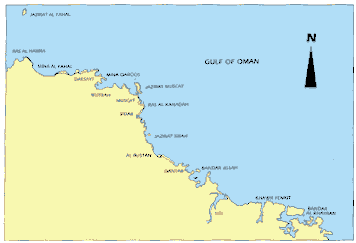
Figure 3. Map of the Capital Area of Muscat
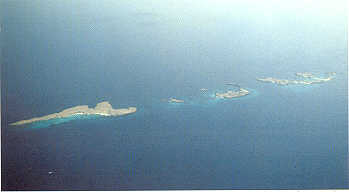
The As Sawadi and Daymaniyat Islands are made of fossilized coral reef and sediments that lay below the ocean approximately 30 mi/lion years ago, as did virtually the entire coastline of the Capital Area. The As Sawadi Island are located close to the shore of the Batinah coast and have limited coral coverage and no modern reefs. By contrast, the Damaniyats are approximately 20 km offshore and are remote from both shoreline related sedimentary effects and from upwelling related temperature instability that may limit coral development further east in the Capital Area (Chapter 4). The Daymaniyats consist of nine islands and many submerged rocks, in an east to west alignment, which form the base for well developed coral reefs. The island's southern shores and those northern shores which have embayments sheltered from offshore waves have formed substantial patch and fringing reefs, growing up from the original rock base. Abundant coral growth extends to up to 20 m depth, in water that has the highest clarity of any coral growing area in Oman. The species-abundance structure for the area suggests a relatively continuously stable physical environment, which has favored the long term growth of the relatively few species that have occupied the available habitat space.
The remaining areas of substantial coral cover in the Muscat area occur further east, along the rocky shores and offshore islands from Qurm to Ras Abu Daud. Many of these areas are accessible from shore and provide relatively easy access to a variety of coral habitats. Most of these are east of Muscat and Mutrah harbors. Local areas of interest are Kalbuh, Cemetery Bay, Darsayt, Cat Island off the Marine Science and Fisheries Center, east of the Al Bustan Palace Hotel, in Bandar Jissah, Bandar Khayran and a small bay at As Sheik. For those with access to a boat, the corals and reefs of Al Fahl Island offer some of the most beautiful reefs and abundant diverse coral coverage to be found in Oman. Of the 39 genera of corals that have been found in the Muscat area, all but three occur at Al Fahl Island, on three nearby rock pinnacles which range in depth from 17 to 35 m or on the sandy bottom between Al Fahl Island and Ras al Hamra.
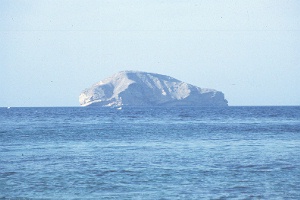
Coral along the Muscat coast is generally sparse on shorelines which face eastward and northward and which are, therefore, more frequently exposed to wave turbulence from the open ocean. Coral coverage on these exposed areas tends to be dominated by two species of soft corals. The major coral coverage and best reef development occurs in coves and embayments sheltered from wind and waves. Where reefs do exist, they are generally small, formed by abundant and contiguous growth of one or two dominant coral species, and the reefs are only a few meters thick. However, reef development exceeds that found in both the Musundam and the Dhofar areas, suggesting that conditions in Muscat waters are the best suited of any in Oman to long term coral growth and survival. Bandar Jissah and Bandar Khayran provide the greatest areas of such sheltered habitat in the Capital Area, and sites of high coral cover and well developed reefs are common in both areas, particularly on the lee sides of the islands that isolate these large embayments from the open ocean.
East of Bandar Khayran a rich variety of species and good coral coverage occurs at a few sites accessible only by boat, and on either side of a small bay at Khaysat as Sheik, which is accessible by road. Generally, coral abundance decreases further east. as the effects of wave turbulence become more dominant. Corals and incipient reefs are found at Ras Abu Daud and Qalhat, but most areas southeast to Ras al Hadd have little coral cover and no reefs. South of Ras al Hadd to the Gulf of Masirah the nearshore environment is entirely sedimentary and corals are absent.
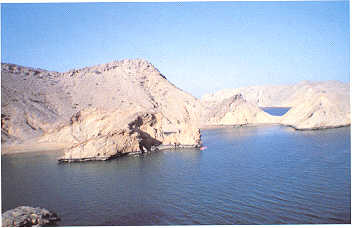
The Gulf of Masirah is partially isolated from the open ocean by the 60 km barrier of Masirah Island, which creates a sheltered environment that receives airborne transport of sand and dust from the adjacent Wahiba Sands. This relatively quiet, somewhat turbid area is the location of Oman's only substantial seagrass beds, and is the habitat of some unique reefs formed primarily by a single species, the Cabbage Coral (Montipora foliosa). This species is common on the northwest and southwest coast of Masirah Island. Reefs comprised of Cabbage Coral and Brain Coral grow along southeast and southwest coasts of Barr al Hikman to the west of Masirah Island. These form the largest and most spectacular coral reefs in Oman. Corals of this type are more tolerant of higher levels of sedimentation and turbidity than most species, and it appears that the quiescent, somewhat silty conditions of the Gulf of Masirah are optimal for growth of this species. Few corals and no developed reefs survive on the east side of Masirah Island, which is subjected to heavy wave turbulence and seasonal upwelling that greatly reduces temperatures along the east shore of the island compared to the west shore.
Dhofar Coast and Al Halaaniyaat (Kuria Muria) Islands
Because of the predominantly sedimentary environment and lack of hard bottom, corals are scarce to absent on the coastline from south of Masirah Island to Kuria Maria Bay. From this area southward the 800 km Dhofar coast and the Al Halaaniyaat Islands provide rocky surfaces and habitat for a variable coverage of reef corals and limited reef development. However, the dominant environmental factor affecting marine life in this region is coastal upwelling of deep, cold water that results form the southeast monsoon winds blowing from May to September. Corals growing in this region must therefore contend annually with water temperatures that drop below 18°C during summer months and must compete with blooms of macroalgae and kelp that respond to the high nutrients that arise during upwelling This unstable physical environment and macroalgal competition undoubtedly restricts the growth and development of corals and coral reefs from what would otherwise be achieved. Despite these restrictions 52 reef forming coral species have been reported for the Dhofar region, less than for the Muscat Capital Area, but one species more than for the Musandam, At least five species of reef corals, one hard alcyonarian (organ pipe coral) and two hydrozoans (fire coral and Stylaster)exist in Dhofar but are not found elsewhere along the Oman coast, probably due to the relative proximity of Dhofar to the Red Sea where these varieties are relatively abundant.
Live coral
coverage is maximum in the AI Halaaniyaat Islands and east of Marbat where
cover can range up to 99% of available substratum. Small reefs up
to 3 m thick can be found in these areas. Available coral habitat diminishes
toward the Yemen border, especially west of Al Mughsayl where steep cliffs
extend only a few meters into the water to a sand bottom. The primary coral
growing areas for the region are further east where relatively sheltered
bays occur at Marbat,Wadi Zead and As Sadh.
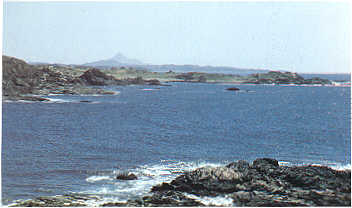
For further information regarding optimal
locations for viewing live corals and coral reefs in Oman the reader is
referred to the excellent diving guide by Salm and Baldwin, as well as
other publications listed in the present bibliography. We will now concentrate
on providing detailed descriptions of the various corals species that are
commonly seen in Oman.